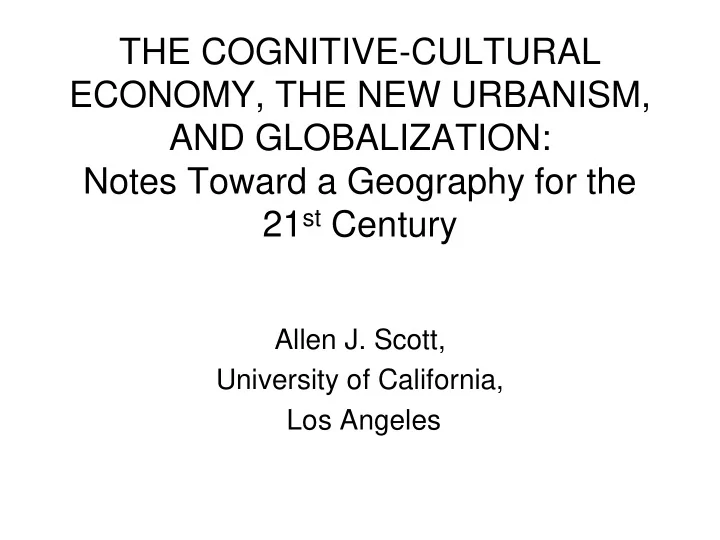

THE COGNITIVE-CULTURAL ECONOMY, THE NEW URBANISM, AND GLOBALIZATION: Notes Toward a Geography for the 21 st Century Allen J. Scott, University of California, Los Angeles
Regimes of accumulation and urbanization • 1. Nineteenth Century Industrialization • 2. Fordism: 1918 – 1969 • 3. The “new economy” of the Twenty-First Century
THE “NEW ECONOMY”: COGNITIVE-CULTURAL CAPITALISM • Digital technologies: Substitute for routine work, complement cognitive and affective work [New division of labor: Levy and Murnane (2004)] • 1. High levels of scientific/technical labor • 2. Human intermediation of services • 3. Symbolic outputs • 4. Aestheticization of commodities Intensification of (global) competition -- but Chamberlinian.
Forms of cognitive-cultural production and work: • Technology-intensive industry • Services • Neo-artisanal production • Media and entertainment • Commodification of experiences (tourism, theme parks, sports events, etc.)
Together with a widening social divide 1. Elite workers of the cognitive-cultural economy. 2. The low –wage tier (often immigrant). (Contrast with white/blue collar stratification of classical fordism)
A partial genealogy of ideas on production relations and social stratification since fordism • V.R. Fuchs (1968): Service economy • D. Bell (1973): Post-industrial society • A. W. Gouldner (1979): The new class • Piore and Sabel (1984): Flexible specialization • J. Hirsch?? (1985): Post-fordism • R. Reich (1991): Symbolic analysts • L. Sklair (2000): Transnational capitalist class • M. Castells (2000): The network society • E. Rullani (2000): Cognitive capitalism • R. Florida (2003): The creative class
Two current perceptions of the new cognitive-cultural order • Managerial discourse:- Flexibility, fast capitalism, human capital, empathy, creativity, adaptability, etc. • Urban policy discourse:- Consumer city (Glaeser), entertainment machine (Clark), creative city (Florida, Landry).
Re-situating the geography of “creativity:” The cognitive-cultural economy and the new urbanism
• Creativity is concretely situated in time-space frameworks (cf. social epistemologies of artistic and scientific production) • Manchester 19 th C.: Textile machinery • Hollywood in the 1930s: Visual storytelling techniques. • Silicon Valley: Semiconductor technologies. • City of London: Financial instruments. [“Creative class” idea is abstracted from specific socio- economic conditions that give real content to the notion of creativity]
Spatial logic of a crucial “concrete situation” • The resurgence of agglomeration in the new economy and the revival of Marshallian analytics (e.g. high technology industry, financial services, cultural products etc.) • 1. Specialized and complementary producers. • 2. Local labor markets • 3. The creative field: the dynamics of learning, creativity, and innovation
… and as a corollary: • Increasing returns to scale • Re-polarization of space • Chamberlinian competition (effects of place) • Metropolitan resurgence and the concentration of cognitive and cultural forms of human capital in large cities.
Motion-picture production companies in Southern California. The inset shows locations of the majors and selected place-names
A new balance between work, life, and leisure in the city 1. Interpenetration of upgraded production space and gentrified social space 2. Iconic architecture and recycling of the built environment: London Docklands, Zürich-West, Bilbao Guggenheim, etc. 3. Proliferation of cultural, entertainment, recreational facilities in large cities. 4. City of the spectacle in cognitive-cultural capitalism.
• NB.: • Amenities are not the foundation of urban growth/prosperity in the contemporary era (cf. Florida)
LOCAL ECONOMIC DEVELOPMENT IN PRACTICE 1. The complex production machinery of the city 2. The spiral of cumulative of causation in city growth 3. The impossibility of sustainable growth in the absence of employment opportunities 4. The privileged role of productive activity in the spiral of interdependencies
An idealized “Silicon Valley” model of growth
The productive/creative field of the city
The global connection 1. The formation of a global mosaic of city- regions. 1. The global diffusion of the cognitive- cultural economy (cf. China, India, South Korea, Mexico, Brazil, etc.)
Global Film Production
The dark side of the dialectic: • Sweatshops • Underclass • Immigrant, often undocumented, labor • Social segmentation • Widening divide
• The decline of community • The withdrawal of public services • The retreat of the public sphere
Beyond the creative city and the creative class: tasks ahead • From the neoliberal city to the social democratic city • Citizenship, community • Toward solidarity, sociability, political community • From the “creative city” of consumer capitalism and possessive individualism toward the convivial city
Recommend
More recommend